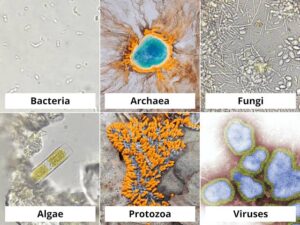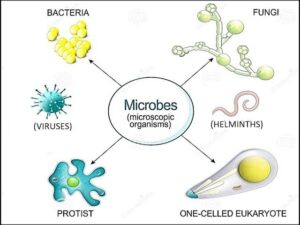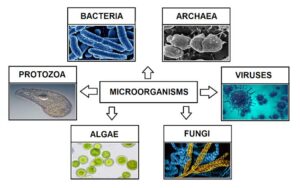Back to: MICROBIOLOGY 100 LEVEL
Welcome to class!
Hello champion! I’m so glad to see your bright and curious mind again today. You’ve been making wonderful progress, and I’m super proud of you. Today, we’re going to talk about some of the smallest living things on earth—but don’t be fooled by their size. These microorganisms can do big things—from helping us bake bread to causing serious diseases. Let’s get to know the major microbial groups: bacteria, viruses, fungi, protozoa, and algae.
Major Microbial Groups: Bacteria, Viruses, Fungi, Protozoa, Algae
Bacteria
These are tiny, single-celled organisms that can be found almost everywhere—in the air, water, soil, and even in your body! Some bacteria are helpful, like the ones that help you digest food in your stomach or those used in making yoghurt and fermented foods like ogi and iru. Others can be harmful and cause diseases like typhoid, tuberculosis, or cholera.

Bacteria don’t have a proper nucleus and come in different shapes—round (cocci), rod-shaped (bacilli), and spiral (spirilla). They reproduce very fast, which is why an infection can spread quickly if not treated.
Viruses
Viruses are even smaller than bacteria and are not considered living until they enter another living cell. Think of a virus like a thief—it needs to enter your “house” (your cell) before it can do anything. Once inside, it takes over the cell and forces it to make more viruses.

Viruses cause many familiar diseases like the common cold, measles, HIV, and COVID-19. They can’t be treated with antibiotics; instead, we use vaccines or antiviral drugs.
Fungi
Fungi can be single-celled like yeast or multi-celled like mushrooms and mould. They don’t make their own food and often grow on decaying material. Some fungi are useful—yeast helps in baking bread and brewing drinks. Others can cause infections like ringworm or spoil stored foods during the rainy season.
Fungi are important in the environment because they help break down dead plants and animals.
Protozoa
These are tiny, animal-like microbes usually found in water. They are single-celled but complex and can move around using tiny hairs, tails, or false feet. Some protozoa cause

diseases like malaria (Plasmodium) and sleeping sickness (Trypanosoma), which are serious health issues in parts of Nigeria and Africa.
Algae
Algae are mostly found in water and can be green, red, or brown. They make their own food using sunlight like plants. While some algae are useful (like those used to make toothpaste or as food supplements), too much algae in rivers or lakes can cause water pollution. Algae are important in the food chain and release oxygen into the water.
Summary
- Bacteria: Tiny, single-celled organisms. Some help us; others cause diseases.
- Viruses: Smaller than bacteria, can only live and reproduce inside living cells.
- Fungi: Can be useful (like yeast) or harmful (like mould and infections).
- Protozoa: Animal-like microbes that live in water and can cause diseases.
- Algae: Plant-like microbes that live in water and make their own food.
Evaluation
- Which microbial group needs to enter a living cell to survive?
- Name one helpful and one harmful example of bacteria.
- Which microorganism causes malaria?
- List all five major microbial groups.
You’ve just learned about some of the tiniest but most powerful living things on earth. You’re building a strong foundation in microbiology, and we at Afrilearn are so proud of your growth. Keep your curiosity alive and never stop learning. See you in the next class!
